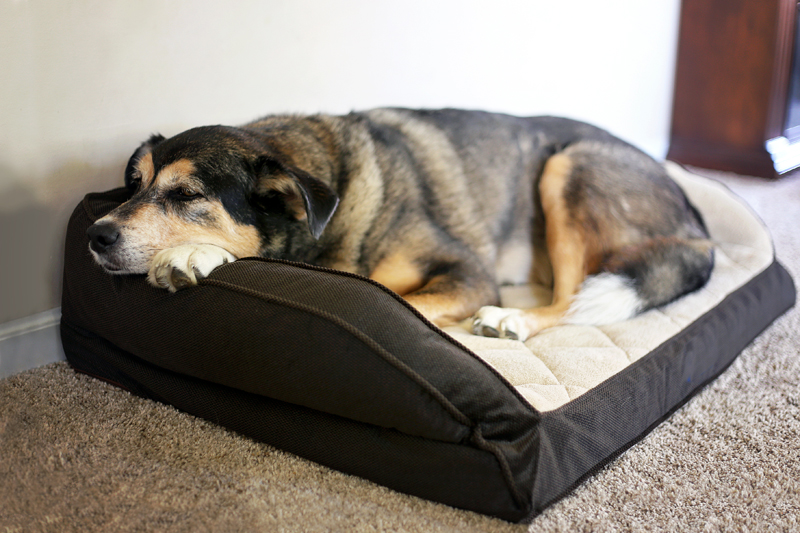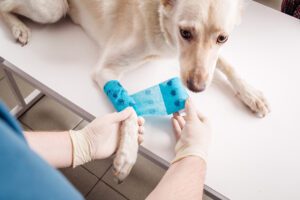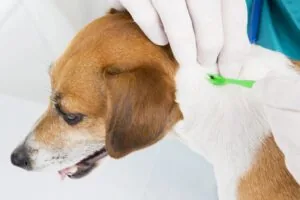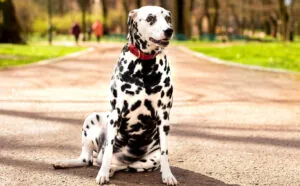Managing Osteoarthritis for our Pets

Osteoarthritis (OA), also known as degenerative joint disease (DJD), is the most common form of arthritis in our pets, affecting approximately a quarter of the population. It is a chronic joint disease characterized by loss of joint cartilage, thickening of the joint capsule and new bone formation around the joint (osteophytosis) and ultimately leading to pain and limb dysfunction. Typically observed in older dogs and cats, arthritis can by caused by injury, infection, the body’s immune system, degenerative diseases or conformational disorders. Other contributing factors to OA include bodyweight, obesity, gender, exercise, and diet.
Symptoms of Arthritis
The signs of osteoarthritis in dogs are similar to those observed in cats. Since cats are avid climbers and jumpers, pet parents will often notice these behaviors diminishing as osteoarthritis progresses. For dogs, arthritis may present as “slowing down” or general stiffness. Take your pets to the veterinarian if they start to show any of the following signs:
- Lameness
- Stiffness when getting up from resting
- Reluctance to walk
- Less willing to exercise and play
- Difficulty climbing stairs
- Difficulty jumping onto furniture or into the car
- Abnormal, lopsided or limping gait
- Yelping, snarling or moving away if an affected joint is touched
- Difficulty posturing to urinate or defecate, or having accidents in the house
- Loss of muscle mass over the limbs and spine
Diagnosing Arthritis
A diagnosis of OA may be done based on an assessment of historical symptoms, such as decreased activity or stiffness, as well as a physical examination which will reveal a decreased range of motion, stiff-legged gait, deformity of the joints, and swelling or pain in the joints.
- Initially, a physical exam will orient towards the affected joint or joints. The veterinarian will palpate the limbs and joints to assess for painful response, thickening of the joint capsule, accumulation of joint fluid (effusion) or sometimes osteophytes and muscle atrophy (wasting).
- The most common imaging modality used is X-ray. These are of limited use though, because they only give information on bone structural changes (osteophytosis) and show only limited soft tissue changes, therefore, should be combined with physical exam findings.
- Other diagnostic tools becoming more popular include magnetic resonance imaging (MRI) which can provide information regarding soft tissue structures (ligaments, menisci) and computed tomography (CT) that is good for assessing bone structural changes in joints with more complex anatomy such as elbows, carpi (wrists) or tarsi (ankles).
Treatment for Arthritis
Unfortunately, osteoarthritis is a progressive disease and there is no known cure. Preventing the development of osteoarthritis through diet, exercise, and the use of protective joint supplements is the best way to keep your pets joints healthy. When osteoarthritis develops, treatment is typically focused on controlling pain, decreasing inflammation, improving the quality of life, and slowing the development of the disease. Treatment of osteoarthritis is usually multimodal, meaning that several different therapies are used simultaneously in order to achieve the best outcome.
- Weight control is by far the most critical aspect of OA management. Fat produces inflammatory mediators that perpetuate the inflammation process and increased body weight put additional force on the joints, causing pronounced OA changes and can ultimately be painful with limited mobility.
- Activity modification: High-impact activities such as running or jumping should be limited as they can cause more inflammation and pain. These activities should be replaced with more controlled activity like leash walks. Low impact consistent exercise is good to help build the muscles around the joints and will eventually promote joint stability.
- Rehabilitation: Animal rehabilitation such as range of motion exercises, therapeutic exercises, and aqua therapy (underwater treadmill, swimming) help to improve joint mobility, increase muscle mass, and improve exercise endurance. Acupuncture, Laser therapy, and other rehabilitation modalities are commonly recommended although there is an overall lack of studies to prove its benefit.
- Pain control: Nonsteroidal anti-inflammatory drugs (carprofen, meloxicam, deracoxib, ketoprofen, etc.) are the most commonly used medication for OA pain control. In patients that cannot tolerate nonsteroidal anti-inflammatory drugs, adjunctive pain medications (amantadine, gabapentin, tramadol, codeine, corticosteroids, acetaminophen, acupuncture) can be considered, although there is an overall lack of studies supporting their efficacy for OA pain management.
- Joint supplements: The exact mechanism of how joint supplements may help alleviate OA pain is not well understood. Chondroitin sulfate, glucosamine sulfate, omega-3-fatty-acid supplementation are the most commonly recommended joint supplements and does not have severe adverse effects.
- Disease modulating agents: This can be given either as a muscle injection (PSGAG) or injection within the joint (corticosteroids, platelet-rich plasma, hyaluronic acid, and stem cell). More research is necessary to ascertain the benefit of disease-modulating agents.
- Surgical management can be indicated and in some instances are the best treatment choice. The surgeries that would be performed are either treatment of the primary cause, such as suture-based or osteotomy-based techniques for knee cranial cruciate ligament rupture, or salvage procedure to remove the painful joint components, such as femoral head and neck excision (FHNE), arthrodesis (fusion of joints), total joint replacement surgery (most commonly in hips, stifles, elbows)
Other Ways to Help Your Pets
Besides the options prescribed by your veterinarian, pet parents can take measures at home to maximize your pets comfort. Providing padded beds, ramps up to cars and steps and no-skid rugs on slippery floors will make a significant difference. You should also block off any stairs to prevent your pet slipping and falling and supervise him when they go outside.
Although it is disheartening to see a beloved companion slowing down, there are many ways to ensure his happiness, quality of life and continued role in your family. Keeping an eye out for the signs of arthritis can help your pet stay in good health for as long as possible.
Share This Post
Recent Posts
About Shallowford Animal Hospital
Shallowford Animal Hospital and The Pet Spa at Shallowford are dedicated to the exceptional, compassionate care your pet deserves. Pets hold a very special place in our families, and we treat yours like our own.



